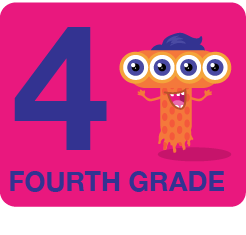Posie and Yeti need your help to figure out the factors! Read the clues and solve all the questions. Quick, doughnuts and ice sheets are in high demand!
Using donuts and grouping them is a fun way for kids to see how to use factors visually. The first example shows kids how different groups could be used to group donuts into baskets with an equal number of donuts in each basket.
Using factors of 16, we can create different whole groups that add up to 16. Factors are numbers that can be multiplied together to get another number. In this case, we're looking for pairs of numbers whose product is 16. Here are the factor pairs of 16 and how we could group the donuts:
1. **1 group of 16 donuts**:
- 1 x 16 = 16
- You have a single group containing all 16 donuts.
2. **2 groups of 8 donuts each**:
- 2 x 8 = 16
- You divide the 16 donuts into two groups, each with 8 donuts.
3. **4 groups of 4 donuts each**:
- 4 x 4 = 16
- You divide the 16 donuts into four groups, each with 4 donuts.
4. **8 groups of 2 donuts each**:
- 8 x 2 = 16
- You divide the 16 donuts into eight groups, each with 2 donuts.
5. **16 groups of 1 donut each**:
- 16 x 1 = 16
- You divide the 16 donuts into sixteen groups, where each group has 1 donut.
In summary, the different ways you can group 16 donuts using whole groups formed by the factors of 16 are:
- 1 group of 16
- 2 groups of 8
- 4 groups of 4
- 8 groups of 2
- 16 groups of 1
These groupings use the factors 16 to form whole, discrete groups that add up to 16 donuts.
Doughnuts and Ice Sheets: A Math Workbook for Factors
GRADES:


Additional Educational Resources:
Estimation and Number Theory Large Workbook - (Grade 4)
Whole Number Multiplication and Division Large Workbook - (Grade 4)
Mental Math (Grade 3 - Math Assessment)
Multiplying and Dividing by 1-Digit (Grade 4 - Math Assessment)

